How to choose a hydraulic pipe bender: types of equipment and its features
A more preferred tool in comparison with similar devices is a hydraulic pipe bender. User preferences are determined by the practicality and high efficiency of hydraulic structures.
Meanwhile, the range of hydraulics for bending pipes surprises with a variety of designs, so even among the best devices of this kind, plumbers have to choose.
In this material we will tell you what hydraulic pipe benders are, let's figure out what rules to follow when choosing, and also give instructions for working with equipment.
The content of the article:
Types of pipe benders with hydraulics
All existing hydraulic pipe benders can be conditionally divided into two types:
- with a mechanical drive;
- with electric drive.
By size and installation method, they are divided into mobile and stationary.
Manual systems include a tool that forms the power traction of the actuator due to the muscular energy of the user. Figuratively, this version of the tool looks simple: the design contains the handle of the hydraulic cylinder pump, which must be manually actuated.
Automatic systems exclude the use of manual force, but they do not show any particular difficulties of mechanization. The pump handle on the hydraulic cylinder is simply replaced by an electric drive.
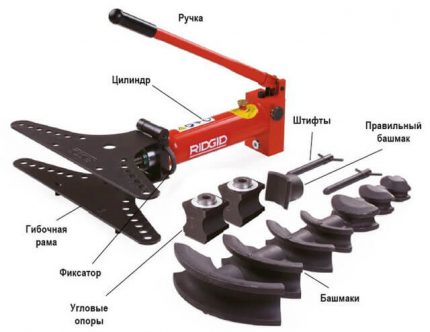
On such a pipe bender, the translational-backward movement of the pump rod drives an electric motor.

Mobile designs include both manual and automated tools. As a rule, these devices are lightweight, compact, convenient for transportation.
But the mobility and compactness of devices somewhat limits their technical characteristics.
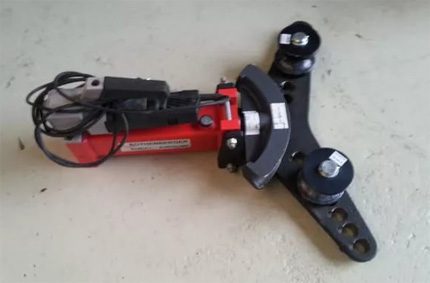
Stationary pipe benders are also represented by manual (lever) structures or equipped with an electric drive (often three-phase). A sufficiently large powerful equipment has already been noted here, designed to perform the bending of strong durable products.
Stationary structures are rigidly installed in one place without the possibility of their rapid transfer.

Pipe benders
Tools with hydraulic power traction in their design are horizontal and vertical. The first designs are distinguished by the placement of the hydraulic cylinder in a horizontal plane. Accordingly, the direction of force action is also carried out in the horizontal plane.
For the second designs, the distinguishing feature is the vertical arrangement of the hydraulic cylinder and the vertical force direction.
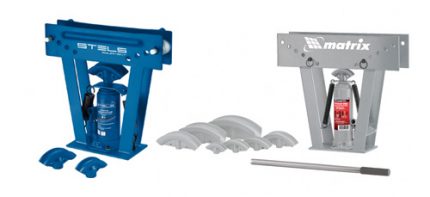
If in this case we judge the advantages and disadvantages taking into account the choice of tool, the basis should be taken:
- pipe processing conditions;
- overall dimensions of pipes;
- area of the working room;
- convenience of work from the point of view of the user.
And now in more detail about the characteristics.
Technical specifications and equipment
The choice of a device for bending pipes, of course, is also reasonable to make with an emphasis on the technical capabilities of the tool. Equally important for the choice is the equipment with additional accessories. For all hydraulic and other pipe benders, the main accessory is the working nozzles, thanks to which pipes of different diameters and profiles are bent.
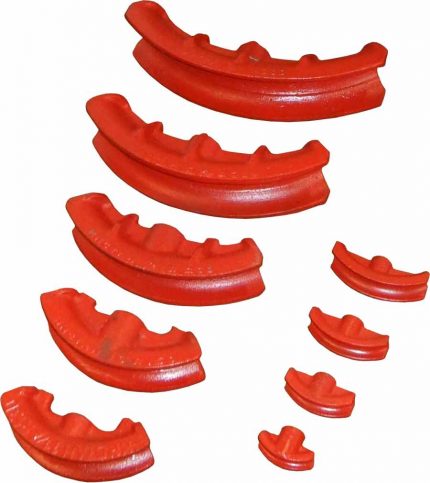
In general, when choosing a pipe bender, it is recommended to pay attention to the following characteristics:
- The force applied to the power rod.
- Distance for power stroke.
- Permissible bending angle.
- The number of working nozzles.
- The radius of the nozzles.
When choosing a hydraulic pipe bender, the design weight and overall dimensions also deserve additional attention.
The force applied to the power rod is a parameter that actually determines several points that allow the performance of a qualitative bending operation:
- the rigidity of the pipe material;
- pipe diameter;
- bending angle.
The force (power) applied to the power rod of a hydraulic pipe bender is measured in kilonewtons (kilograms or tons). Depending on the design, the hydraulic cylinders of pipe benders are capable of creating a pressure of 5000 to 20,000 kg. This should also be borne in mind when choosing a tool for working with pipes.
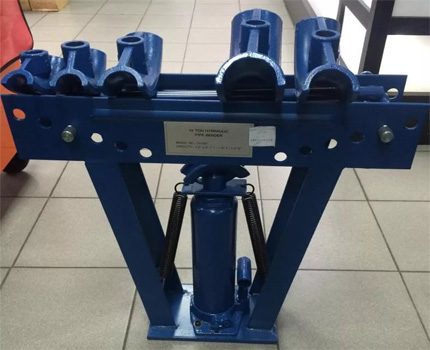
The stiffness of the pipe depends on the structure of the material and production technology. In fact, it is not necessary to calculate the degree of rigidity. It is enough to determine the pipe wall thickness in order to compare the degree of rigidity with the working pressure of the pipe bender. For example, a tool giving a force of 10 tons on a power rod is designed to bend steel pipes with wall thicknesses up to 5 mm.
Most hydraulic tools support the processing of pipes having a nominal bore diameter of 1/2 - 2 inches (15 - 50 mm). But there are also designs that bend steel round and shaped pipes of large diameters. The ability of a pipe bender to bend products with a large bore diameter is usually determined by the overall dimensions of the tool and the force parameters on the power rod.
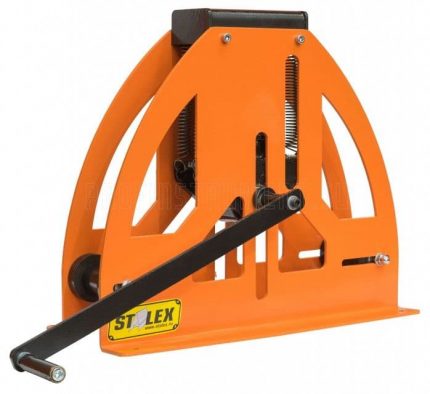
Industrial manual and automated mechanisms with hydraulics by most models provide bending at an angle from 0 to 90º. This value is quite enough for many variations of installation in the arrangement of water supply and other communications. However, if necessary, it is possible to choose a tool with a bend angle of up to 180º. A good example (to be discussed below) is the development of Stalex in the image of the HB-12 model.
A brief overview of industrial designs
The choice of industrial models can be focused, for example, on the products of domestic companies. But foreign-made products also express themselves quite actively.
Budget manual options
TG series hydraulic pipe benders are available with a diameter of 15 to 50 mm and a wall thickness of up to 4.5 mm. The device easily bends products at an angle of up to 90º due to the force of 12 tons created on the power rod. The simplest design and high-quality materials are the key to the long service life of this device. Designed to work with round pipes.
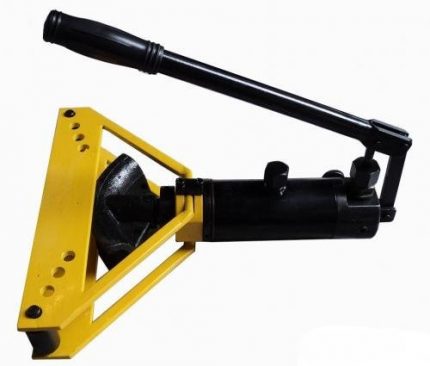
No less interesting is another development from Stalex. In terms of technical capabilities, the HB-12 pipe bender is not inferior to the TG models. This device is designed to work with pipes having a wall thickness of no more than 2.5 - 4.0 mm.
The main purpose is the processing of round pipes, but the work with the profile is also supported. The design weighing only 40 kg is recommended to carefully study the owners of private households. For domestic use this is a good choice.
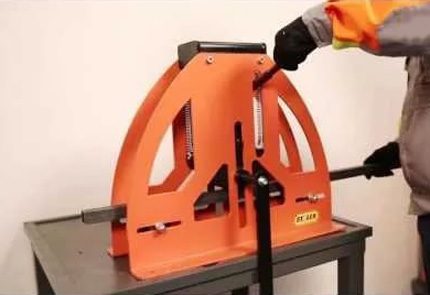
The next candidate to choose is the Zubr manual vertical hydraulic tool, which generates a rod force of up to 10 tons. The model bends pipes with a diameter of 15 - 76 mm with a wall thickness of up to 5 mm.
A bend angle of up to 90º is easily created without additional heating of the pipe. It is completed with four spare rollers and working nozzles in the amount of 8 pieces.
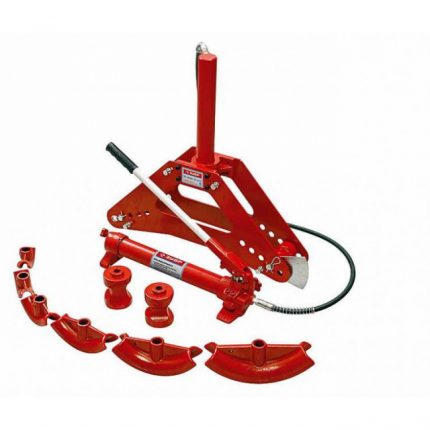
The horizontal design of the Renza SWG-2 pipe bender is positioned as the optimal choice for the housing and communal sector. On the installation of pipelines for various purposes, this tool is indispensable.
Bends pipes up to 50 mm in outer diameter at an angle of up to 90º. Power rod stroke 250 mm.
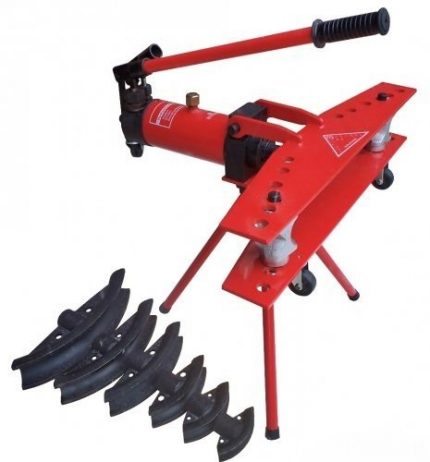
For ease of use, the tool is supplemented with a tripod stand and wheels. A device for bending round pipes is intended.
Expensive Automated Devices
Equipped with an electric motor, the Ridgid tool is a US product, the choice is quite reasonable when it comes to industrial applications. The company's products are represented by a series of designs (three serial developments), each of which has its own advantages.
This is one of those effective tools that allow you to bend at angles of up to 180º using special shoes. Despite a decent weight (75 - 110 kg), the device belongs to the universal portable equipment.
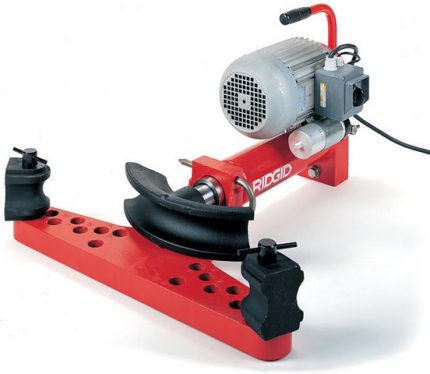
The design of the French engineers from Virax has a practically similar design. The device with an electric drive (single-phase) is designed to work with pipes with an outer diameter of 12 - 50 mm.
The hydraulic cylinder provides a force of 8 tons on the stem. The maximum possible bending angle can be 90º.
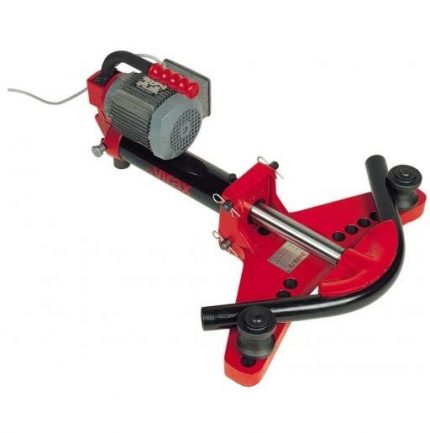
It is also logical to supplement this list with a German instrument - a product of Rothenberger. To select a universal mobile electric pipe bender, the tool is suitable without further ado. A convenient and necessary technical tool at a construction site, in the housing and communal services system, in the gas supply sector, etc.
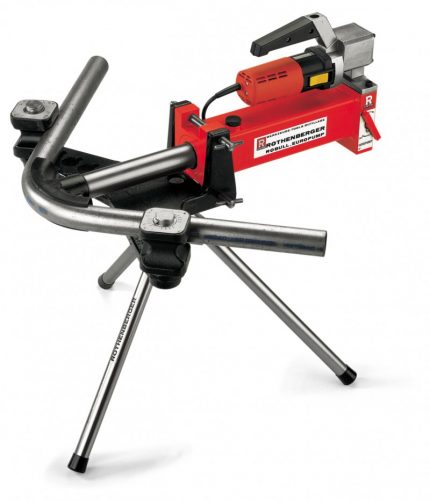
Rothenberger's Robull Me model provides bends with radii of up to 90º for 3/8 to 2-inch metal pipes. The electric motor power is 900 W, with a hydraulic cylinder power of 150 kN (15,000 kg).
The design is equipped with a mechanism for automatically returning the piston of the hydraulic cylinder. The volume of the refilled hydraulic oil is 1 liter. The kit includes an installation tripod, two bending templates. Two modifications of the device are offered - with an open and a closed frame.
If desired, a pipe bender can be built with your own hands. And how to do it you can read here.
Manual bender
The process of performing the work is simple and, nevertheless, requiring compliance with the sequence of actions and some technical features.
For example, work using a tool from Rothenberger is as follows:
- It is necessary to prepare a pipe bender - fix the bending frame on the hydraulic cylinder body with the spacer bolts included in the kit.
- Lift the upper part of the frame and set the side templates to the specific fold parameters.
- Position the side templates at an equal distance relative to the axis of the hydraulic cylinder.
- Perform pipe bending operation.
Considering the high level of power generated by hydraulics, special attention should be paid to the correct (symmetrical) layout of the templates. The slightest distortion can cause damage to the tool.
We also recommend that you familiarize yourself with the technological subtleties of bending metal pipes. They are detailed in this stuff.
Using a pipe bender, we must not forget about the maintenance of the device. Cleaning the hydraulic cylinder from dust and dirt, checking the hydraulic fluid level, timely replacement (cleaning) of the working filter, checking valves are mandatory maintenance procedures that are performed periodically.
Conclusions and useful video on the topic
The video contains information about the design features of pipe benders and the nuances of working with different models:
Which type of tool is better: horizontal, vertical, mobile, stationary - it’s difficult to clearly determine. The user himself usually chooses the configuration of the tool based on the conditions of its use. Meanwhile, universal designs are increasingly appearing among the range of hydraulic pipe benders. The appearance of such models actually removes the question of choice for some specific parameters.
If you have experience using hydraulic pipe bending equipment, share it with our readers. Tell us which model of pipe bender you use, are you satisfied with its work? Please leave comments in the block under the article. There you can ask questions of interest on the topic of the article.

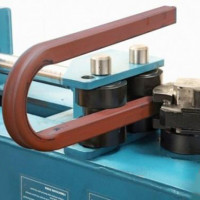 How to build a pipe bender for your profile pipe yourself: an overview of the best homemade products
How to build a pipe bender for your profile pipe yourself: an overview of the best homemade products  How to make a pipe bender with your own hands: examples of the best homemade products
How to make a pipe bender with your own hands: examples of the best homemade products 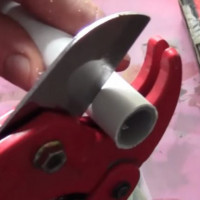 Pipe cutter for plastic pipes: types, which is better to choose and how to use it correctly
Pipe cutter for plastic pipes: types, which is better to choose and how to use it correctly 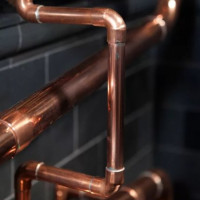 Copper pipes and fittings: types, marking, features of the arrangement of a copper pipeline
Copper pipes and fittings: types, marking, features of the arrangement of a copper pipeline 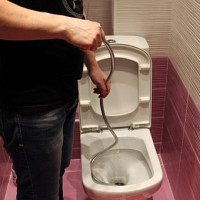 A cable for cleaning pipes: types, how to choose the right + instructions for use
A cable for cleaning pipes: types, how to choose the right + instructions for use 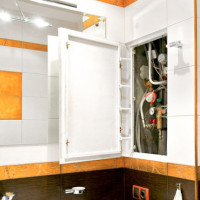 Revision plumbing hatches for the bathroom and toilet: types, placement rules, mounting features
Revision plumbing hatches for the bathroom and toilet: types, placement rules, mounting features  How much does it cost to connect gas to a private house: the price of organizing gas supply
How much does it cost to connect gas to a private house: the price of organizing gas supply  The best washing machines with dryer: model rating and customer tips
The best washing machines with dryer: model rating and customer tips  What is the color temperature of light and the nuances of choosing the temperature of the lamps to suit your needs
What is the color temperature of light and the nuances of choosing the temperature of the lamps to suit your needs  Replacement of a geyser in an apartment: replacement paperwork + basic norms and requirements
Replacement of a geyser in an apartment: replacement paperwork + basic norms and requirements
My garage neighbor let me use the SWG-2 Renza. It bends the pipe evenly and leaves the walls even. In short, I liked it. True, even such a "budget" pipe bender is a little expensive for me.